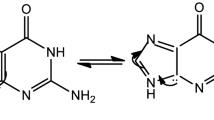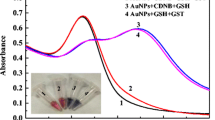Abstract
The affinities of apigenin, chrysin, daidzein and quercetin for human serum albumin (HSA) were studied in the presence and absence of Pb2+, Ni2+, Zn2+, Mg2+ and Mn2+. The fluorescence intensities of HSA decrease remarkably with increasing concentration of these four flavonoids. Adding apigenin and chrysin resulted in blue-shifts of HSA from λ em=336 to 332 nm and 330 nm, respectively. However, quercetin showed an obvious red-shift of HSA from λ em=336 to 347 nm whereas daidzein hardly affected the λ em of HSA. The λ em shifts induced by flavonoids in the presence of mental ions were much bigger than those in the absence of these ions. Pb2+, Ni2+, Zn2+, Mg2+ and Mn2+ increased the quenching constants of these four flavonoids for HSA by 19.2 % to 43 %, 47.7 % to 117 %, 23.3 % to 64.4 %, 9.29 % to 42.2 % and 18 % to 55.6 %, respectively. The affinities of apigenin, chrysin, daidzein and quercetin for HSA increased about 9.49 %, 3.63 %, 5.73 % and 2.32 %, respectively, in the presence of Pb2+. Ni2+ improved the affinities of apigenin, chrysin, daidzein and quercetin for HSA by about 4.79 %, 0.85 %, 11.91 % and 10.55 %, respectively. Zn2+ enhanced the affinities of apigenin, chrysin, daidzein and quercetin for HSA by about 1.03 %, 1.34 %, 1.96 % and 13.14 %, respectively. Mg2+ increased the affinities of apigenin, chrysin, daidzein and quercetin for HSA by about 2.03 %, 0.7 %, 1.39 % and 2.07 %, respectively. Mn2+ increased the affinities of apigenin, chrysin, daidzein and quercetin for HSA by about 2.46 %, 6.71 %, 12.3 % and 4.10 %, respectively.

















Similar content being viewed by others
References
Blade, C., Arola, L., Salvado, M.J.: Hypolipidemic effects of proanthocyanidins and their underlying biochemical and molecular mechanisms. Mol. Nutr. Food Res. 54, 37–59 (2010)
van Dorsten, F.A., Grun, C.H., van Velzen, E.J.J., Jacobs, D.M., Draijer, R., van Duynhoven, J.P.M.: The metabolic fate of red wine and grape juice polyphenols in humans assessed by metabolomics. Mol. Nutr. Food Res. 54, 897–908 (2010)
Morabito, G., Trombetta, D., Brajendra, K.S., Ashok, K.P., Virinder, S.P., Naccari, C., Mancari, F., Saija, A., Cristani, M., Firuzi, O., Saso, L.: Antioxidant properties of 4-methylcoumarins in in vitro cell-free systems. Biochimie 92, 1101–1107 (2010)
Mladenka, P., Macakova, K., Zatloukalova, L., Rehakova, Z., Singh, B.K., Prasad, A.K., Parmar, V.S., Jahodar, L., Hrdina, R., Saso, L.: In vitro interactions of coumarins with iron. Biochimie 92, 1108–1114 (2010)
Natella, F., Lorrain, B., Prasad, A.K., Parmar, V.S., Saso, L., Scaccini, C.: 4-Methylcoumarins as antioxidants: scavenging of peroxyl radicals and inhibition of human low-density lipoprotein oxidation. Biochimie 92, 1147–1152 (2010)
Courts, F.L., Williamson, G.: The C-glycosyl flavonoid, aspalathin, is absorbed, methylated and glucuronidated intact in humans. Mol. Nutr. Food Res. 53, 1104–1111 (2009)
Bae, M.J., Ishii, T., Minoda, K., Kawada, Y., Ichikawa, T., Mori, T., Kamihira, M., Nakayama, T.: Albumin stabilizes (–)-epigallocatechin gallate in human serum: binding capacity and antioxidant property. Mol. Nutr. Food Res. 53, 709–715 (2009)
Ishii, T., Minoda, K., Bae, M.J., Mori, T., Uekusa, Y., Ichikawa, T.: Binding affinity of tea catechins for HSA: characterization by high-performance affinity chromatography with immobilized albumin column. Mol. Nutr. Food Res. 54, 1–7 (2010)
Frazier, R.A., Deaville, E.R., Green, R.J., Stringano, E., Willoughby, I., Plant, J.: Interactions of tea tannins and condensed tannins with proteins. J. Pharm. Biomed. Anal. 51, 490–495 (2010)
Mandeville, J.S., Froehlich, E., Tajmir-Riahi, H.A.: Study of curcumin and genistein interactions with human serum albumin. J. Pharm. Biomed. Anal. 49, 468–474 (2009)
Kraghhansen, U.: Molecular aspects of ligand-binding to serum-albumin. Pharmacol. Rev. 33, 17–53 (1981)
Xiao, J., Cao, H., Wang, Y., Zhao, J., Wei, X.: Glycosylation of dietary flavonoids decreases the affinities for plasma protein. J. Agric. Food Chem. 57, 6642–6648 (2009)
Laussac, J.P., Sarkar, B.: Characterization of the copper(II)–transport and nickel(II)–transport site of human-serum albumin – studies of copper(II) and nickel(II) binding to peptide 1-24 of human-serum albumin by C-13 and H-1-NMR spectroscopy. Biochemistry (Moscow) 23, 2832–2838 (1984)
Liang, Y.Q.Z.H., Shen, P.W.: The structural study on metal centre in Mn(II)–HSA and Mn(II)–BSA complex. Chin. Sci. Bull. 39, 1452–1457 (1994)
Liang, H., Huang, J., Tu, C.Q., Zhang, M., Zhou, Y.Q., Shen, P.W.: The subsequent effect of interaction between Co2+ and human serum albumin or bovine serum albumin. J. Inorg. Biochem. 85, 167–171 (2001)
Liang, H., Ouyang, D., Hu, X.Y., Tai, J.Z., He, J.T., Zhou, Y.Q.: Structural studies on metal serum albumin – III. Slow conformational transition of HSA and BSA induced by Ni2+ ion. Acta Chimi. Sin. 56, 662–667 (1998)
Sadler, P.J., Viles, J.H.: 1H and 13C NMR investigations of Cd2+ and Zn2+ binding sites on serum albumin: competition with Ca2+, Ni2+, Cu2+, and Zn2+. Inorg. Chem. 35, 4490–4496 (1996)
Shen, X.C., Bian, H.D., Tu, C.Q., Zhang, H.Z., Liang, H., Zhou, Y.Q., Shen, P.W.: Binding equilibrium study between Ni(II) and HSA or BSA. Chin. J. Inorg. Chem. 16, 77–78 (2000)
Zhou, Y.Q., Hu, X.Y., Dou, C., Liu, H., Wang, S.Y., Shen, P.W.: Structural studies on metal serum-albumin: 1. The interaction of Zn(II), Cd(II) and Hg(II) with HSA and BSA. Biophys. Chem. 42, 201–211 (1992)
Zhou, Y.Q., Wang, Y.W., Hu, X.Y., Huang, J.S., Hao, Y.Q., Liu, H., Shen, P.W.: Equilibrium dialysis of metal–serum albumin: 1. Successive stability-constants of Zn(II)-serum albumin and the Zn2+-induced cross-linking self-association. Biophys. Chem. 51, 81–87 (1994)
Jiang, C.Q., Gao, M.X., Meng, X.Z.: Study of the interaction between daunorubicin and human serum albumin, and the determination of daunorubicin in blood serum samples. Spectrochim. Acta Part A Mol. Biomol. Spectrosc. 59, 1605–1610 (2003)
Lu, J.X., Zhang, G.Z., Wang, Y.M.: The interaction of 5-fluorouracil with deoxyribonucleic acid and serum albumin. Chin. J. Anal. Chem. 29, 192–194 (2001)
Xiao, J.B., Chen, T.T., Cao, H., Chen, L.S., Yang, F.: Molecular property-affinity relationship of flavonoids and flavonoids for human serum albumin in vitro. Mol. Nutr. Food Res. (in press). doi:10.1002/mnfr.201000208
Xiao, J.B., Cao, H., Wang, Y.F., Yamamoto, K., Wei, X.L.: Structure-affinity relationship of flavones on binding to serum albumins: effect of hydroxyl groups on ring A. Mol. Nutr. Food Res. 54, S253–S260 (2010)
Xiao, J.B., Cao, H., Chen, T.T., Yang, F., Liu, C.X., Xu, X.C.: Molecular property-binding affinity relationship of flavonoids for common rat plasma proteins in vitro. Biochimie (2010). doi:10.1016/j.biochi.2010.08.013
Xiao, J.B., Chen, T.T., Chen, L.S., Cao, H., Yang, F., Bai, Y.L.: CdTe quantum dots (QDs) improve the affinities of baicalein and genistein for human serum albumin in vitro. J. Inorg. Biochem. 104, 1148–1155 (2010)
Xiao, J.B., Chen, X.Q., Jiang, X.Y., Hilczer, M., Tachiya, M.: Probing the interaction of trans-resveratrol with bovine serum albumin: a fluorescence quenching study with Tachiya model. J. Fluoresc. 18, 671–678 (2008)
Xiao, J.B., Chen, L.S., Yang, F., Liu, C.X., Bai, Y.L.: Green, yellow and red emitting CdTe QDs decreased the affinities of apigenin and luteolin for human serum albumin in vitro. J. Hazard. Mater. 82, 696–703 (2010)
Xiao, J.B., Suzuki, M., Jiang, X.Y., Chen, X.Q., Yamamoto, K., Xu, M.: Influence of B-ring hydroxylation on interactions of flavonols with bovine serum albumin. J. Agric. Food Chem. 56, 2350–2356 (2008)
Xiao, J., Chen, X., Zhang, L., Talbot, S.G., Li, G.C., Xu, M.: Investigation the mechanism of enhanced effect of EGCG on huperzine A inhibiting acetylcholinesterase activity in rats by multi-spectroscopic method. J. Agric. Food Chem. 56, 910–915 (2008)
Acknowledgements
The authors are grateful for financial support sponsored by the Natural Science Foundation of Shanghai (10ZR1421700), Innovation Program of the Shanghai Municipal Education Commission (10YZ68), Leading Academic Discipline Project of the Shanghai Municipal Education Commission (J50401), “Chen Guang” project supported by the Shanghai Municipal Education Commission and Shanghai Education Development Foundation (09CG46), and the Program of Shanghai Normal University.
Author information
Authors and Affiliations
Corresponding author
Rights and permissions
About this article
Cite this article
Yang, F., Wang, J., Liu, C. et al. Metal Ions Enhance the Affinities of Flavonoids for Human Serum Albumin in Vitro . J Solution Chem 41, 976–993 (2012). https://doi.org/10.1007/s10953-012-9846-z
Received:
Accepted:
Published:
Issue Date:
DOI: https://doi.org/10.1007/s10953-012-9846-z




